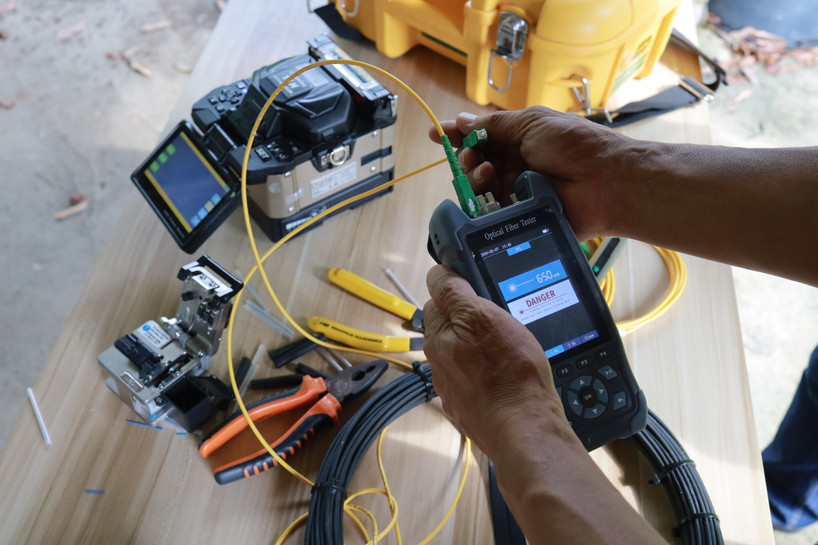Transmitting data through light might sound simple, but building a high-performing and reliable fiber optic network requires a solid grasp of its architecture—especially when it comes to testing. Unlike copper-based systems, fiber optic networks demand specialized testing techniques designed for the unique behavior of light transmission.
The Three Essential Layers of an Optical Fiber
Every fiber optic cable consists of three core layers, each crucial to protecting and guiding the light signal:
- Core: This is the innermost part of the fiber, made of ultra-pure glass or plastic. It’s the pathway through which light travels and requires the highest clarity to ensure minimal signal disruption.
- Cladding: Surrounding the core is a second layer of glass with a slightly lower refractive index. This difference enables total internal reflection, which keeps the light contained within the core as it moves down the fiber.
- Coating: The outer layer protects the delicate glass beneath. It provides resistance to environmental factors and physical stress, making it possible for the fiber to bend and flex without breaking.
Single-Mode vs. Multimode Fiber: What’s the Difference?
Fiber types are generally categorized as either single-mode or multimode, based on the size of the core and how light travels within them:
- Multimode Fiber: With a larger core, multimode fiber allows multiple light paths or “modes.” This can lead to higher signal loss and reduced bandwidth, making it ideal for shorter distances.
- Single-Mode Fiber: Featuring a smaller core, this fiber supports just one light path, offering greater performance with lower attenuation over long distances. However, its precision requires more advanced (and often pricier) equipment for alignment and connection.
Key Testing Methods & Tools for Fiber Optics
Testing ensures that a fiber optic network is installed properly, ready for service, and reliable over time. Here are the primary tools and methods used by technicians:
- Fiber End-Face Inspection: Clean connector end faces are critical. Even tiny particles or oils can cause significant signal degradation or even damage. Proper inspection using dedicated fiber scopes should be standard before any connection is made.
- Fiber Continuity Testing: This verifies that a fiber is connected end-to-end. Visual fault locators (VFLs) can identify breaks or tight bends using red light. For long spans, an Optical Time Domain Reflectometer (OTDR) is used to trace signal paths and locate faults.
- Optical Loss Testing: Signal loss, or attenuation, occurs naturally over distance. An Optical Loss Test Set (OLTS) measures this loss accurately by injecting a known signal at one end and analyzing how much is received at the other.
- Optical Power Measurement: Once the system is active, technicians use optical power meters to measure the strength of the signal received, typically in decibel-milliwatts (dBm).
- Acceptance Testing: This process establishes a baseline for optical performance. It involves connecting a calibrated light source and power meter using reference cables, and requires scrupulously clean connectors to ensure precise results.
- OTDR Testing: The OTDR sends light pulses into the fiber and evaluates the backscattered signal. This helps locate splices, connectors, breaks, and other events. Many modern handheld OTDRs now include features like integrated fiber inspection, power meters, and VFLs.
Find the Jonard Fiber Optic Power Meter here: Fiber Optic Power Meter with FC/SC/LC Adapters (JN FPM-50A) - Get It At GUS!
Find the Jonard Fiber Inspection Microscope here: Jonard Fiber Inspection Microscope 200x
Find Fiber Optic Cleaning Solutions here: Pull Lubricant available at Georgia Underground
Why Clean Connections Are Critical
The tiny core of a fiber makes it extremely sensitive to even microscopic contamination. In fact, dirty connectors are the leading cause of network failure. Regular inspection and proper cleaning (when necessary) are essential for maintaining performance.
Inspection tools reveal dust, oil, scratches, cracks, and other issues. Today’s video inspection scopes offer high magnification and safety, with some models even delivering automated pass/fail results and image storage for documentation.
Importantly, cleaning should only be done if contamination is found. Unnecessary cleaning can introduce new debris or damage the connector. When cleaning is needed, always use the correct tools and methods for the type of contamination.
Your Fiber Optic Solutions Partner
At Georgia Underground Superstore, we understand the critical nature of fiber optic installations—and we’re here to help you get it right. From test equipment and inspection tools to expert guidance, we provide everything utility contractors and network professionals need to build and maintain high-performance fiber networks. With a vast product inventory, fast shipping, and a knowledgeable team, we’re your go-to resource for fiber optic supplies and solutions across the U.S.
Find Fiber Optic Cable, Cable Handling and Installation Equipment here: Fiber Optic Cable, Cable Handling and Installation

